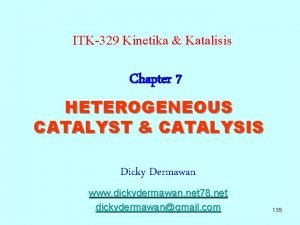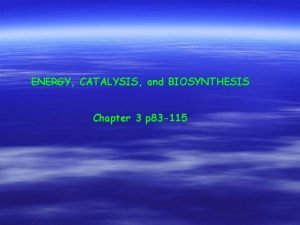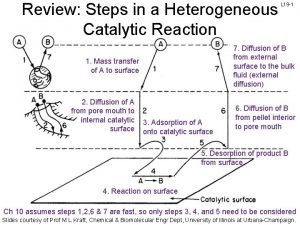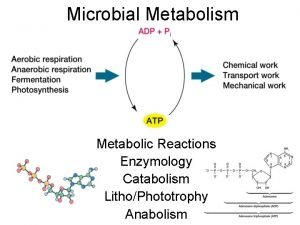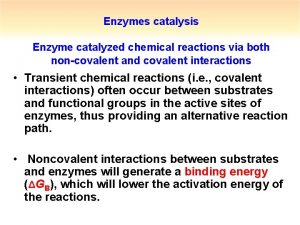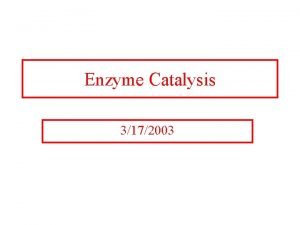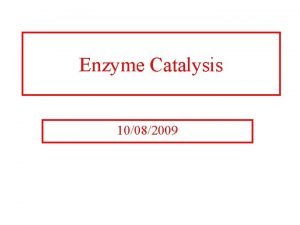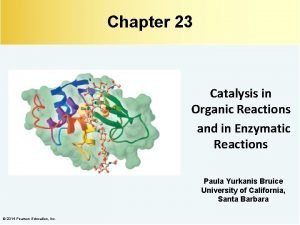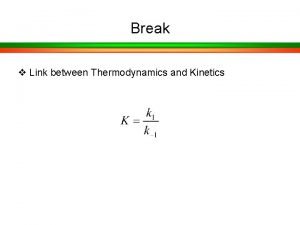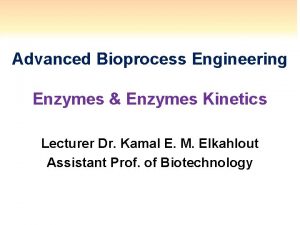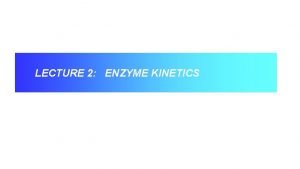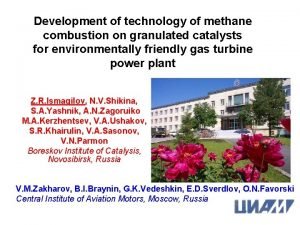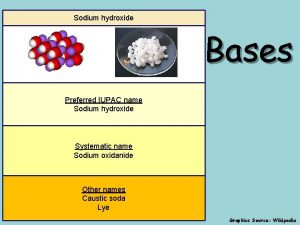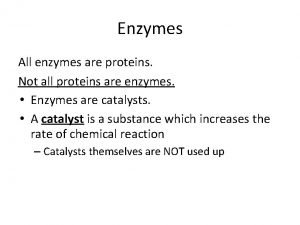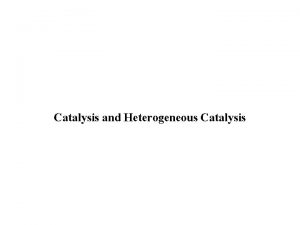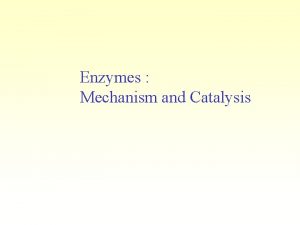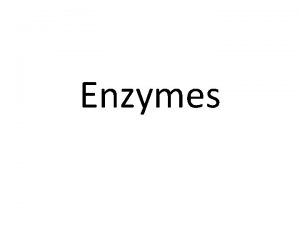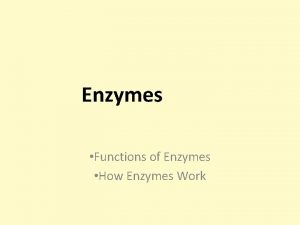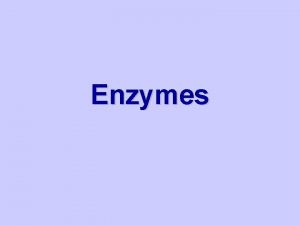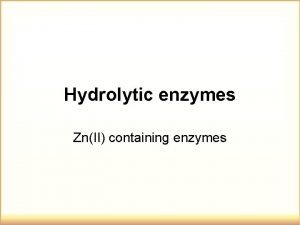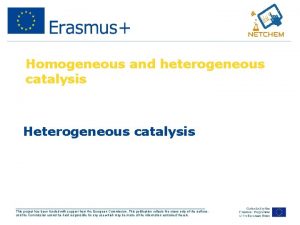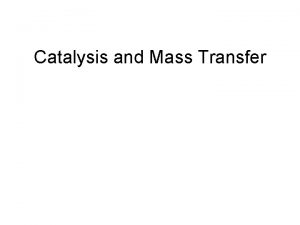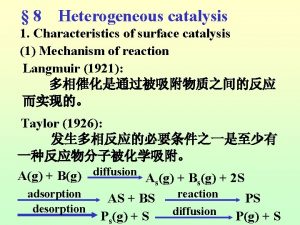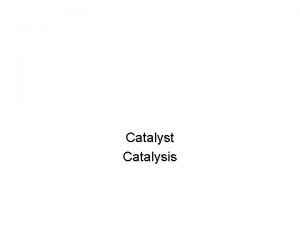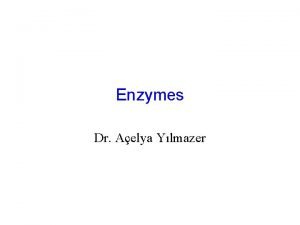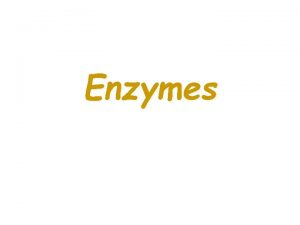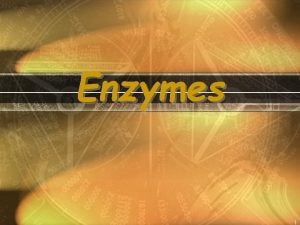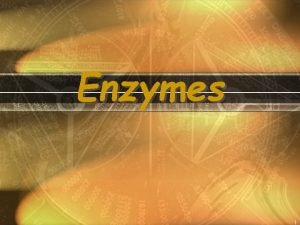Enzymes Mechanism and Catalysis Enzymes DO NOT change
























- Slides: 24

Enzymes : Mechanism and Catalysis

• • Enzymes DO NOT change the equilibrium constant of a reaction Enzymes DO NOT alter the amount of energy consumed or liberated in the reaction (standard free energy change, G°) Enzymes DO increase the rate of reactions that are otherwise possible Enzymes DO decrease the activation energy of a reaction ( G°‡)





Enzyme/Substrate Interactions • • Lock and key model substrate (key) fits into a perfectly shaped space in the enzyme (lock) • • Induced fit model substrate fits into a space in the enzyme, causing the enzyme to change conformation change in protein conformation leads to an exact fit of substrate with enzyme Following catalysis, the product(s) no longer fits the active site and is released Enzymes and Enzyme Kinetics

• • Strain and Distortion model The binding of the substrate results in the distortion of the substrate in a way that makes the chemical reaction easier.

General Base Catalysis I: Ester Hydrolysis

General Base Catalysis II: Ester Hydrolysis The hydrolysis of esters proceeds readily under in the presence of hydroxide. It is base catalyzed. However, the rate of hydrolysis is also dependent on imidazole buffer concentration. Imidazole can accept a proton from water in the transiton state in order to generate the better nucleophile, hydroxide. It can also re-donate the proton to the paranitrophenylacetate in order to generate a good leaving group.

General Acid Catalysis : Ester Hydrolysis Electrostatic interactions are much stronger in organic solvents than in water due to the dielectric constant of the medium. The interior of enzymes have dielectric constants that are similar to hexane or chloroform

Catalysis by Metal Ions Catalysis I: Ester Hydrolysis Metal ions that are bound to the protein (prosthetic groups or cofactors) can also aid in catalysis. In this case, Zinc is acting as a Lewis acid. It coordinates to the non-bonding electrons of the carbonyl, inducing charge separation, and making the carbon more electrophilic, or more susceptible to nucleophilic attack.

Catalysis by Metal Ions Catalysis II: Ester Hydrolysis Metal ions can also function to make potential nucleophiles (such as water) more nucleophilic. For example, the pka of water drops from 15. 7 to 6 -7 when it is coordinated to Zinc or Cobalt. The hydroxide ion is 4 orders of magnitude more nucleophilic than is water.

Covalent Catalysis : Acetoacetate Decarboxylase

Enzyme Inhibition • Certain compounds inhibit enzymes – decrease the rates of their catalysis • • inhibition can be reversible or irreversible 3 types of reversible inhibitors – competitive inhibitors – non-competitive inhibitors – un-competitive inhibitors • Irreversible inhibition – suicide inhibitors • the various types of inhibitors can be distinguished by the kinetics of their inhibition Enzymes and Enzyme Kinetics

http: //www. cs. stedwards. edu/chem/Chemistry/ CHEM 43/chymotrypsin. mov

Chymotrypsin Mechanism (Step 1)

Chymotrypsin Mechanism (Step 2)

Chymotrypsin Mechanism (Step 3)

Chymotrypsin Mechanism (Step 4)

Chmyotrypsin Mechanism (Step 5)

Chymotrypsin Mechanism (Step 6)

Chymotrypsin Mechanism (Step 7)

 Langmuir-hinshelwood mechanism heterogeneous catalysis
Langmuir-hinshelwood mechanism heterogeneous catalysis Energy catalysis and biosynthesis
Energy catalysis and biosynthesis Decao
Decao Enzymatic catalysis
Enzymatic catalysis What is covalent catalysis
What is covalent catalysis What is covalent catalysis
What is covalent catalysis What is covalent catalysis
What is covalent catalysis Specific acid base catalysis
Specific acid base catalysis Specific acid base catalysis
Specific acid base catalysis Specific acid base catalysis
Specific acid base catalysis Enzyme catalyze
Enzyme catalyze Difference between atomic and molecular spectroscopy
Difference between atomic and molecular spectroscopy Boreskov institute of catalysis
Boreskov institute of catalysis Hydroxide catalysis bonding
Hydroxide catalysis bonding Not genuine not true not valid
Not genuine not true not valid Not all enzymes are proteins
Not all enzymes are proteins Mechanism of change
Mechanism of change Chemical changes example
Chemical changes example Absolute change and relative change formula
Absolute change and relative change formula Whats the difference between chemical and physical change
Whats the difference between chemical and physical change Change in supply and change in quantity supplied
Change in supply and change in quantity supplied Which is an example of a physical change
Which is an example of a physical change Rocks change due to temperature and pressure change
Rocks change due to temperature and pressure change Whats the difference between a chemical and physical change
Whats the difference between a chemical and physical change First order of change
First order of change
